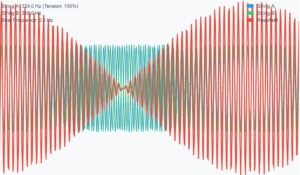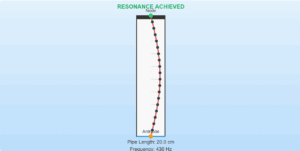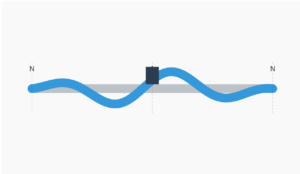Sound Wave Physics
Laplace Correction Formula: \( v = \sqrt{\frac{\gamma P}{\rho}} \)
Where γ is the adiabatic index, P is pressure, and ρ is density
Newton originally proposed that sound propagation was an isothermal process, leading to the formula \( v = \sqrt{P/\rho} \). However, this underestimated the speed of sound by about 15%.
Laplace corrected this by recognizing that sound waves propagate adiabatically (without heat transfer) rather than isothermally, introducing the γ (gamma) factor to account for the ratio of specific heats.
| Method | Speed at STP (m/s) | Error |
|---|---|---|
| Newton's Formula | 280 | 15% too low |
| Laplace Correction | 331.3 | 0.1% error |
| Measured Value | 331.0 | - |
In an adiabatic process:
- No heat is transferred (dQ = 0)
- The relationship between pressure and volume is \( PV^\gamma = \text{constant} \)
- For air, γ ≈ 1.4 (ratio of specific heats at constant pressure and volume)
Sound waves create rapid compressions and rarefactions - too fast for heat transfer to occur, making the adiabatic assumption correct.
Example
Question:
Estimate the speed of sound in air at standard temperature and pressure. The mass of 1 mole of air is \(29.0 \times 10^{-3}\,\mathrm{kg}\).
Solution:
Step 1: Calculate density of air at STP.
1 mole of any gas occupies \(22.4\,\mathrm{L}\) at STP.
\[
\rho_0 = \frac{\text{mass of 1 mole}}{\text{volume of 1 mole at STP}} = \frac{29.0 \times 10^{-3}\,\mathrm{kg}}{22.4 \times 10^{-3}\,\mathrm{m^3}} = 1.29\,\mathrm{kg\,m^{-3}}
\]
Step 2: Using Newton's formula for sound speed:
\[
v = \sqrt{\frac{P}{\rho}} = \sqrt{\frac{1.01 \times 10^5\,\mathrm{N\,m^{-2}}}{1.29\,\mathrm{kg\,m^{-3}}}} = 280\,\mathrm{m\,s^{-1}}
\]
Step 3: Laplace correction.
Newton's result is ~15% lower than experimental value (\(331\,\mathrm{m\,s^{-1}}\)).
Laplace showed that sound propagation is adiabatic, not isothermal.
For adiabatic processes: \(PV^{\gamma} = \text{constant}\)
The correct formula becomes:
\[
v = \sqrt{\frac{\gamma P}{\rho}}
\]
For air, \(\gamma = 1.4\), giving \(v = 331\,\mathrm{m\,s^{-1}}\), which matches experiment.



